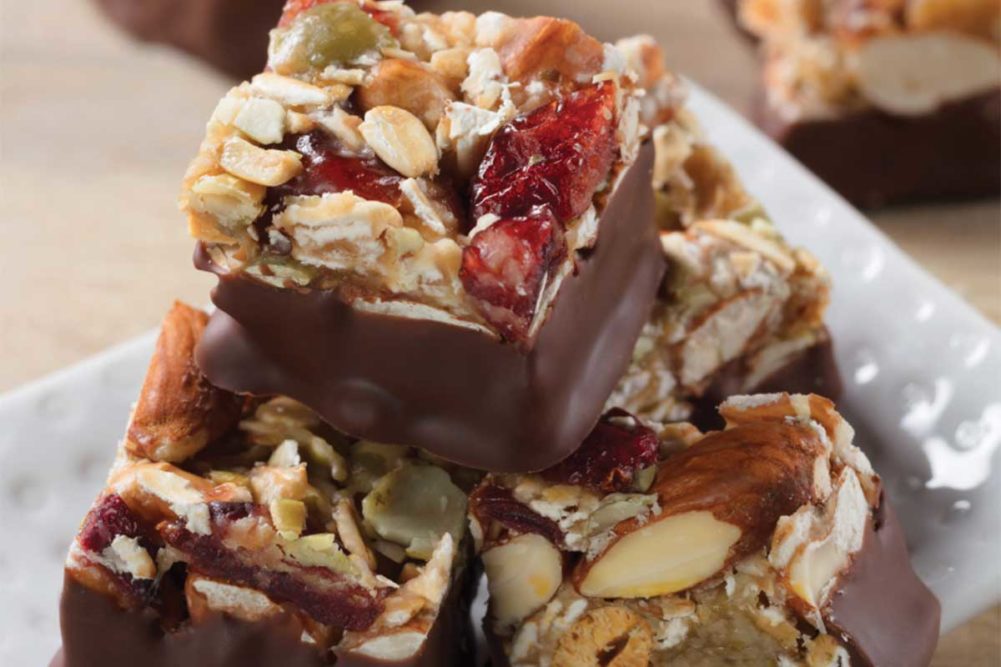It can be sweet, bitter, dark, milky and even white or ruby red. It’s chocolate, and bakers have been using it forever to add color, flavor and even texture to all types of baked goods. But what if those chips, drops, chunks and shavings provided more?
“More” can take on many definitions. For some, that means sustainable growing practices and responsible sourcing for a healthier planet and better farming communities. For others, it may be the flavanol content of the cocoa component, as these bioactive compounds have been shown to assist in the prevention of chronic diseases associated with inflammation, oxidative stress and metabolic disorders.
Sometimes it’s micro- and macronutrients or other beneficial compounds that use chocolate as the delivery vehicle. These value-added chocolate ingredients are growing in number and present bakers with new ways to differentiate in the marketplace. And sometimes, “more” is “less” or even “none,” as in no added sugars, dairy-free, no cocoa beans and more.
“Informed consumers not only want to know where their chocolate comes from, they are also looking more closely at ingredient labels and at front-of-package claims,” said John Pimpo, marketing director, Parker Food Group. “Consumers increasingly want to know more about what went into making this chocolate.”
There’s a lot to explore when it comes to how chocolate gets made, as it is a complex process. All chocolate originates from the cacao beans that grow in pods on the Theobroma cacao tree. Ripe pods are harvested and opened to extract the beans. How these beans get processed determines the final chocolate product.
Cacao refers to cacao beans that have not been roasted, while cocoa is made from fermented and dried cacao beans. Marketers, unfortunately, often use these two unregulated terms interchangeably, resulting in consumer confusion.
The desirable natural antioxidants found in chocolate come from cacao. Processing decreases antioxidant content.
“Baking and other heat processing also decreases the natural antioxidant content,” said An Ho, research and development director, International Food Products Corp. “The optimal way to preserve the antioxidants is for bakers to use natural cacao and dark chocolate in their recipes.”
In the United States, there are currently three basic types of chocolate — dark, milk and white — defined in the Code of Federal Regulations. The code mandates that milk and dark chocolates must contain chocolate liquor, while all three chocolates must be made with cocoa butter. The regulations are very specific regarding the other optional ingredients — sugar, milk/whey solids, flavoring and emulsifier — that may be included in each of the three types of “real” chocolate.
A fourth type of chocolate — ruby — has been available since 2019 and can be called chocolate under a temporary permit issued to its manufacturer, Barry Callebaut USA, by the US Food and Drug Administration (FDA). Ruby chocolate has a distinctive fresh berry-fruity taste and a pink color. Ruby chocolate is made from the ruby cocoa bean. No berry flavors or colors are added. Barry Callebaut is working with the FDA toward recognizing ruby chocolate with its own standard of identity.
“The standards of identity prescribe the composition of chocolate but do not limit the use of ‘extras,’” said Jeffrey Fine, senior director, customer innovation, AAK USA. “Common inclusions in the North American market include nuts, fruit, crisped rice, pretzels and cookie bits. The use of these inclusions provides a variety of eating textures for consumers to enjoy, and the choice of inclusions is only limited by one’s imagination.”
This article is an excerpt from the April 2022 issue of Baking & Snack. To read the entire feature on Chocolate, click here.

